Glen Allen Office
(804) 747-3380
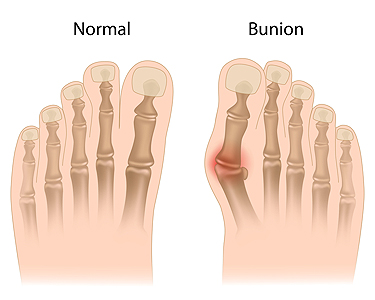
A bunion is a bony bump that forms at the base of the big toe, causing the toe to deviate towards the other toes. Symptoms of a bunion include a visible protrusion on the side of the foot, often accompanied by swelling, redness, and inflammation surrounding the affected area. Pain and tenderness are common, especially when wearing tight or narrow shoes. Over time, the big toe may turn inwards, overlapping the second toe, which can lead to further discomfort and difficulty walking. The skin over the bunion can become thickened and callused due to constant friction and pressure. In some cases, persistent pain and restricted movement in the big toe joint can occur. Early recognition and management of bunion symptoms can prevent progression and can help to alleviate discomfort. If you have a bunion, it is suggested that you seek advice from a podiatrist who can offer you effective relief and treatment solutions.
If you are suffering from bunions, contact one of our podiatrists of The Podiatry Center. Our doctors can provide the care you need to keep you pain-free and on your feet.
What Is a Bunion?
A bunion is formed of swollen tissue or an enlargement of boney growth, usually located at the base joint of the toe that connects to the foot. The swelling occurs due to the bones in the big toe shifting inward, which impacts the other toes of the foot. This causes the area around the base of the big toe to become inflamed and painful.
Why Do Bunions Form?
Genetics – Susceptibility to bunions are often hereditary
Stress on the feet – Poorly fitted and uncomfortable footwear that places stress on feet, such as heels, can worsen existing bunions
How Are Bunions Diagnosed?
Doctors often perform two tests – blood tests and x-rays – when trying to diagnose bunions, especially in the early stages of development. Blood tests help determine if the foot pain is being caused by something else, such as arthritis, while x-rays provide a clear picture of your bone structure to your doctor.
How Are Bunions Treated?
If you have any questions, please feel free to contact one of our offices located in Richmond and Glen Allen, VA . We offer the newest diagnostic and treatment technologies for all your foot care needs.
 Children’s footwear plays a significant role in the development of their feet and the way they walk, known as their gait. Shoes that are ill-fitted or lack proper support may lead to many foot conditions, such as flat feet, hammertoe, or even issues with posture and balance. Investing in properly fitting shoes helps children's feet grow correctly, supports a natural gait, and aids in maintaining good body alignment. Shoes that are too tight or too loose, can lead to discomfort, or possible long-term health issues. Children’s feet are still developing, and their bones, muscles, and ligaments are not fully formed. Wearing unsupportive footwear during these stages of life can cause permanent damage and affect their ability to participate in daily activities. Quality shoes should have a flexible sole to allow natural movement, plenty of room for the toes, and good arch support to encourage proper foot mechanics. If any issues regarding your child’s foot health arise, it is suggested to visit a podiatrist for a thorough exam and appropriate treatment.
Children’s footwear plays a significant role in the development of their feet and the way they walk, known as their gait. Shoes that are ill-fitted or lack proper support may lead to many foot conditions, such as flat feet, hammertoe, or even issues with posture and balance. Investing in properly fitting shoes helps children's feet grow correctly, supports a natural gait, and aids in maintaining good body alignment. Shoes that are too tight or too loose, can lead to discomfort, or possible long-term health issues. Children’s feet are still developing, and their bones, muscles, and ligaments are not fully formed. Wearing unsupportive footwear during these stages of life can cause permanent damage and affect their ability to participate in daily activities. Quality shoes should have a flexible sole to allow natural movement, plenty of room for the toes, and good arch support to encourage proper foot mechanics. If any issues regarding your child’s foot health arise, it is suggested to visit a podiatrist for a thorough exam and appropriate treatment.
The health of a child’s feet is vital to their overall well-being. If you have any questions regarding foot health, contact one of our podiatrists of The Podiatry Center. Our doctors can provide the care you need to keep you pain-free and on your feet.
Tips for Keeping Children's Feet Healthy
If you have any questions, please feel free to contact one of our offices located in Richmond and Glen Allen, VA . We offer the newest diagnostic and treatment technologies for all your foot care needs.
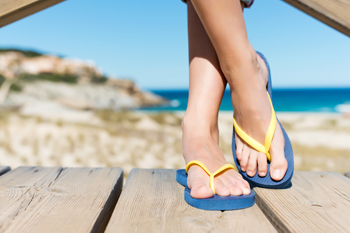 While flip-flops may signal the arrival of sunny summer days, they can also pose risks to foot health. These seemingly carefree shoes offer minimal support and protection, potentially leading to various foot problems. The lack of arch support and cushioning in flip-flops can alter the way people walk, causing them to grip the sandals with their toes, leading to strain and fatigue. This altered gait can also impact other parts of the body, potentially causing knee, hip, or back pain. If you opt for flip-flops, choose high-quality leather shoes that offer better support and durability. Ensure they fit well and reserve them for short periods or casual occasions. If you experience discomfort or have issues from wearing flip-flops, it is suggested that you consult a podiatrist for individualized treatment and advice on appropriate footwear choices for optimal foot health.
While flip-flops may signal the arrival of sunny summer days, they can also pose risks to foot health. These seemingly carefree shoes offer minimal support and protection, potentially leading to various foot problems. The lack of arch support and cushioning in flip-flops can alter the way people walk, causing them to grip the sandals with their toes, leading to strain and fatigue. This altered gait can also impact other parts of the body, potentially causing knee, hip, or back pain. If you opt for flip-flops, choose high-quality leather shoes that offer better support and durability. Ensure they fit well and reserve them for short periods or casual occasions. If you experience discomfort or have issues from wearing flip-flops, it is suggested that you consult a podiatrist for individualized treatment and advice on appropriate footwear choices for optimal foot health.
Flip-flops can cause a lot of problems for your feet. If you have any concerns about your feet or ankles, contact one of our podiatrists from The Podiatry Center. Our doctors will assist you with all of your foot and ankle needs.
Flip-Flops and Feet
Flip-flops have managed to become a summer essential for a lot of people. While the shoes may be stylish and easy to slip on and off, they can be dangerous to those who wear them too often. These shoes might protect you from fungal infections such as athlete’s foot, but they can also give you foot pain and sprained ankles if you trip while wearing them.
When Are They Okay to Wear?
Flip-flops should only be worn for very short periods of time. They can help protect your feet in places that are crawling with fungi, such as gym locker rooms. Athlete’s foot and plantar warts are two common fungi that flip-flops may help protect your feet against.
Why Are They Bad for My Feet?
These shoes do not offer any arch support, so they are not ideal for everyday use. They also do not provide shock absorption or heel cushioning which can be problematic for your feet. Additionally, you may suffer from glass cuts, puncture wounds, and stubbed toes since they offer little protection for your feet.
More Reasons Why They Are Bad for Your Feet
If you have any questions, please feel free to contact one of our offices located in Richmond and Glen Allen, VA . We offer the newest diagnostic and treatment technologies for all your foot care needs.

Ankle pain, a common complaint with various origins, can significantly impact daily activities and quality of life. Acute ankle pain often arises from sudden injuries, such as sprains or fractures, resulting from twists, falls, or impacts. Symptoms of these injuries include sharp pain, swelling, and bruising. Conversely, chronic ankle pain may develop gradually over time, due to repetitive stress or underlying conditions like tendonitis or arthritis. Such persistent discomfort may be accompanied by stiffness and weakness in the ankle joint. Overuse injuries, such as Achilles tendonitis or peroneal tendonitis, can lead to localized pain along the back or sides of the ankle. Contributing factors include improper footwear, biomechanical issues, and insufficient warm-up or conditioning. If you have developed ankle pain for any reason, it is suggested that you consult a podiatrist who can determine the cause and offer appropriate treatment options.
Ankle pain can be caused by a number of problems and may be potentially serious. If you have ankle pain, consult with one of our podiatrists from The Podiatry Center. Our doctors will assess your condition and provide you with quality foot and ankle treatment.
Ankle pain is any condition that causes pain in the ankle. Due to the fact that the ankle consists of tendons, muscles, bones, and ligaments, ankle pain can come from a number of different conditions.
Causes
The most common causes of ankle pain include:
Symptoms
Symptoms of ankle injury vary based upon the condition. Pain may include general pain and discomfort, swelling, aching, redness, bruising, burning or stabbing sensations, and/or loss of sensation.
Diagnosis
Due to the wide variety of potential causes of ankle pain, podiatrists will utilize a number of different methods to properly diagnose ankle pain. This can include asking for personal and family medical histories and of any recent injuries. Further diagnosis may include sensation tests, a physical examination, and potentially x-rays or other imaging tests.
Treatment
Just as the range of causes varies widely, so do treatments. Some more common treatments are rest, ice packs, keeping pressure off the foot, orthotics and braces, medication for inflammation and pain, and surgery.
If you have any questions, please feel free to contact one of our offices located in Richmond and Glen Allen, VA . We offer the newest diagnostic and treatment technologies for all your foot care needs.
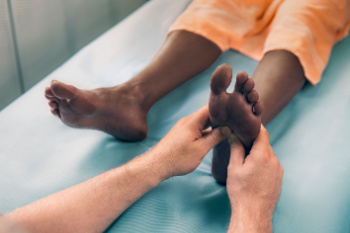
Arthritis, a condition causing joint inflammation, manifests in various forms, each impacting the feet differently. Osteoarthritis, the most common type, affects the cartilage, leading to joint pain and stiffness. In feet, it often targets the big toe, making it painful to walk or stand. Rheumatoid arthritis, an autoimmune disease, affects joints symmetrically, often leading to deformities in the feet such as bunions and hammertoes. Gout, characterized by sudden, severe attacks of pain, swelling, and redness, typically targets the big toe joint. Psoriatic arthritis, linked with psoriasis, can cause swelling in the toes. Ankylosing spondylitis, affecting the spine and large joints, may also cause inflammation in the feet, leading to stiffness and discomfort. If you have any arthritic foot pain, it is suggested that you make an appointment with a podiatrist who can offer a personalized treatment to help alleviate discomfort and improve mobility.
Arthritis can be a difficult condition to live with. If you are seeking treatment, contact one of our podiatrists from The Podiatry Center. Our doctors can provide the care you need to keep you pain-free and on your feet.
Arthritic Foot Care
Arthritis is a joint disorder that involves the inflammation of different joints in your body, such as those in your feet. Arthritis is often caused by a degenerative joint disease and causes mild to severe pain in all affected areas. In addition to this, swelling and stiffness in the affected joints can also be a common symptom of arthritis.
In many cases, wearing ill-fitting shoes can worsen the effects and pain of arthritis. Wearing shoes that have a lower heel and extra room can help your feet feel more comfortable. In cases of rheumatoid arthritis, the arch in your foot may become problematic. Buying shoes with proper arch support that contour to your feet can help immensely.
Alleviating Arthritic Pain
It is best to see your doctor for the treatment that is right for your needs and symptoms. Conditions vary, and a podiatrist can help you determine the right method of care for your feet.
If you have any questions, please feel free to contact one of our offices located in Richmond and Glen Allen, VA . We offer the newest diagnostic tools and technology to treat your foot and ankle needs.

Maintaining a safe work environment is essential in protecting yourself from the risk of falls, which can result in injuries and productivity disruptions. Implementing effective fall prevention measures is vital for ensuring workplace safety. Start by conducting a thorough risk assessment to identify potential hazards, such as wet floors, uneven surfaces, or inadequate lighting. Implementing proper housekeeping practices, including promptly cleaning up spills and removing obstacles from walkways, can significantly reduce the risk of falls. Ask your employer to provide appropriate safety equipment, such as non-slip footwear, harnesses, and guardrails for elevated work areas to further safety. If you have fallen at work and have injured your feet or ankles from working on your feet, it is suggested that you seek expert advice from a podiatrist who can effectively treat these injuries.
Preventing falls among the elderly is very important. If you are older and have fallen or fear that you are prone to falling, consult with one of our podiatrists from The Podiatry Center. Our doctors will assess your condition and provide you with quality advice and care.
Every 11 seconds, an elderly American is being treated in an emergency room for a fall related injury. Falls are the leading cause of head and hip injuries for those 65 and older. Due to decreases in strength, balance, senses, and lack of awareness, elderly persons are very susceptible to falling. Thankfully, there are a number of things older persons can do to prevent falls.
How to Prevent Falls
Some effective methods that older persons can do to prevent falls include:
Falling can be a traumatic and embarrassing experience for elderly persons; this can make them less willing to leave the house, and less willing to talk to someone about their fears of falling. Doing such things, however, will increase the likelihood of tripping or losing one’s balance. Knowing the causes of falling and how to prevent them is the best way to mitigate the risk of serious injury.
If you have any questions, please feel free to contact one of our offices located in Richmond and Glen Allen, VA . We offer the newest diagnostic and treatment technologies for all your foot care needs.
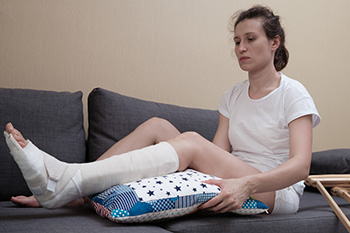
Osteoporosis isn't just about fragile bones. It can impact balance, leading to falls and injuries beyond just the ankle and foot. Even without a specific foot or ankle injury, you might notice pain and swelling in these areas, signaling potential bone issues. Several factors contribute to the likelihood of developing osteoporosis, some within your control and others not. Age is a significant factor, with the risk rising notably for women over 50 and men over 70. Women are more predisposed to osteoporosis and genetics can further increase the risk. While you can't change your age, gender, or genetics, certain lifestyle factors help to reduce your risk. A balanced diet rich in essential nutrients helps maintain bone strength. Hormonal changes, such as low estrogen levels in women and testosterone in men, can affect bone mass and should be monitored. Excessive alcohol consumption and smoking can weaken bones and overall health. Regular exercise, especially weight-bearing activities, can strengthen bones and improve bone density. Even moderate daily exercise, like taking a walk, can make a significant difference in bone health. By understanding these factors and making informed choices, you can take proactive steps to protect your bone health and minimize the risk of osteoporosis-related complications in your feet. If you are experiencing foot or ankle pain that may be connected to osteoporosis, it is suggested that you make an appointment with a podiatrist for an exam and treatment options.
A broken foot requires immediate medical attention and treatment. If you need your feet checked, contact one of our podiatrists from The Podiatry Center. Our doctors can provide the care you need to keep you pain-free and on your feet.
Broken Foot Causes, Symptoms, and Treatment
A broken foot is caused by one of the bones in the foot typically breaking when bended, crushed, or stretched beyond its natural capabilities. Usually the location of the fracture indicates how the break occurred, whether it was through an object, fall, or any other type of injury.
Common Symptoms of Broken Feet:
Those that suspect they have a broken foot shoot seek urgent medical attention where a medical professional could diagnose the severity.
Treatment for broken bones varies depending on the cause, severity and location. Some will require the use of splints, casts or crutches while others could even involve surgery to repair the broken bones. Personal care includes the use of ice and keeping the foot stabilized and elevated.
If you have any questions please feel free to contact one of our offices located in Richmond and Glen Allen, VA . We offer the newest diagnostic and treatment technologies for all your foot and ankle needs.
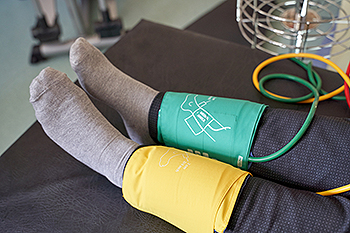 Peripheral artery disease, or PAD, is a condition where the arteries that supply blood to the legs and feet become narrowed due to plaque buildup. Diabetes significantly increases the risk of developing this condition. High blood sugar levels contribute to the accumulation of fatty deposits in the blood vessels, which can harden and reduce blood flow. This process, known as atherosclerosis, is more common in diabetes patients due to the chronic high glucose levels that damage the blood vessel walls. Symptoms of PAD include pain, cramping, or heaviness in the legs and feet during activities like walking. Complications like ulcers, which often appear on the feet, can lead to serious infections. Regular check-ups with a podiatrist, or foot doctor, are important to prevent any issues and manage foot and lower leg health. If you have symptoms of peripheral artery disease, it is suggested that you make an appointment with a podiatrist today.
Peripheral artery disease, or PAD, is a condition where the arteries that supply blood to the legs and feet become narrowed due to plaque buildup. Diabetes significantly increases the risk of developing this condition. High blood sugar levels contribute to the accumulation of fatty deposits in the blood vessels, which can harden and reduce blood flow. This process, known as atherosclerosis, is more common in diabetes patients due to the chronic high glucose levels that damage the blood vessel walls. Symptoms of PAD include pain, cramping, or heaviness in the legs and feet during activities like walking. Complications like ulcers, which often appear on the feet, can lead to serious infections. Regular check-ups with a podiatrist, or foot doctor, are important to prevent any issues and manage foot and lower leg health. If you have symptoms of peripheral artery disease, it is suggested that you make an appointment with a podiatrist today.
Peripheral artery disease can pose a serious risk to your health. It can increase the risk of stroke and heart attack. If you have symptoms of peripheral artery disease, consult with one of our podiatrists from The Podiatry Center. Our doctors will assess your condition and provide you with quality foot and ankle treatment.
Peripheral artery disease (PAD) is when arteries are constricted due to plaque (fatty deposits) build-up. This results in less blood flow to the legs and other extremities. The main cause of PAD is atherosclerosis, in which plaque builds up in the arteries.
Symptoms
Symptoms of PAD include:
It is important to note that a majority of individuals never show any symptoms of PAD.
Diagnosis
While PAD occurs in the legs and arteries, Podiatrists can diagnose PAD. Podiatrists utilize a test called an ankle-brachial index (ABI). An ABI test compares blood pressure in your arm to you ankle to see if any abnormality occurs. Ultrasound and imaging devices may also be used.
Treatment
Fortunately, lifestyle changes such as maintaining a healthy diet, exercising, managing cholesterol and blood sugar levels, and quitting smoking, can all treat PAD. Medications that prevent clots from occurring can be prescribed. Finally, in some cases, surgery may be recommended.
If you have any questions, please feel free to contact one of our offices located in Richmond and Glen Allen, VA . We offer the newest diagnostic and treatment technologies for all your foot care needs.